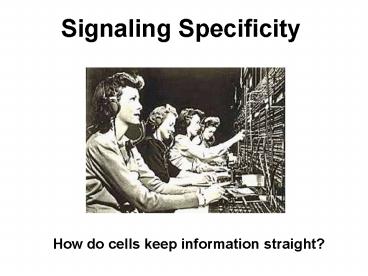Signaling Specificity - PowerPoint PPT Presentation
1 / 31
Title:
Signaling Specificity
Description:
... all-or-none switch: Xenopus oocyte maturation. Ferrell JE Jr, Machleder EM. The biochemical basis of an all-or-none cell fate switch in Xenopus oocytes. Science. ... – PowerPoint PPT presentation
Number of Views:49
Avg rating:3.0/5.0
Title: Signaling Specificity
1
Signaling Specificity
How do cells keep information straight?
2
Network level specificity
- Growing examples of specificity involving larger
network - Unique combinatorial response via multi-pathway
integration - Cross inhibition of pathways
- Specificity through pathway dynamics
3
Cross-inhibition
Signal leakage error correction
4
Mutation of Osmo-MAPK leads to mating cross-talk
in yeast
INPUT
mating output with osmostimulus
wt - DSte11 - D Pbs2 DHog1
ORourke Herskowitz
- Model Hog1 normally has neg. feedback loop
phosphorylates Sho1 in downregulatory manner
(Dohlman). Disruption leads to build up of
active Ste11 crosstalk to Ste7 (mating) - Also
- Hog1 pathway shows rapid adaptation (van
Oudenaarden) - Hog1 mating responses to dual stimuli can be
mutually exclusive under certain conditions
(Ramanathan)
5
Cross-Inhibition between yeast mating
filamentation pathways
Both pathways share MAPKKK (Ste11) MAPKK
(Ste7) How can information flowing through same
kinases be distinct? But Tec1 is filamentation
specific transcription factor
6
Tec1 is degraded with pheromone stimulation
Mating MAPK
Filamentation MAPK
Madhani lab ( Liu Lab)
- Pheromone induced Tec1 degradation is dependent
on Fus3 activity - Tec1 is substrate of Fus3 (phospho-Tec1
recognized by E3 ligase)
7
Cross-Inhibition between yeast mating
filamentation pathways
Model Pheromone induction leads to some signal
leakage to Kss1. But activated Fus3
cross-inhibits filamentation program by
phosphorylating and inducing degradation of Tec1.
8
Specificity Through Signaling Dynamics
- Different stimuli activate ERK MAPK, but often
with distinct dynamics - Stimuli that lead to sustained activation can
yield specific response
9
Same mediator kinase, different dynamics
3T3 cells stimulated with EGF vs. PDGF
Difference in signal duration can lead to very
distinct responses in identical cell type, even
though signal is mediated by the exact same kinase
John Blenis
10
SLOW
FAST
Feedforward Loop allows detection of sustained
ERK activation
John Blenis
11
Summary
- Mechanisms of Specificity
- Enzyme specificity (active site)
- Docking motifs
- Modular recognition domains
- Scaffolds accessory factors
- Spatial or temporal segregation
- Network level specificity
Hierarchy of mechanisms contribute to
specificty Multiple, combinatorial solutions to
the problem Still cant accurately predict
specificity in most cases
12
IV. Making Decisions Shaping Responses
- What determines the quantitative input/ouput
response of a signaling device or pathway? - How are complex response decisions made by
molecules and networks?
13
Questions Focus on a few example behaviors
- How do signaling systems
- - Integrate multiple inputs perform logical
operations? - Generate diverse dose-response profiles?
- e.g. graded switch-like (digital) irreversible
(memory) - Control timing, duration of signaling?
- Yield spatially precise responses (e.g.
polarization)
Molecular and Systems Level Solutions
14
Integration of multiple signals
15
Src Kinase regulation
Ligands that disrupt intramolecular interactions
serve two functions Activation AND localization
16
Regulatory domains function cooperatively to
repress kinase
John Kuriyan
- Ligands for SH2 and SH3 domains act
synergistically to activate kinase - Strongest activators are those with both SH2 and
SH3 ligand motifs
17
Shaping Dose Response
- Sigmoidal
- Ultrasensitive
- Switch-like
- Hyperbolic
- Graded (linear)
- Bistable
- all-or-none
- Memory
- Hysteresis
18
Memory locking bistable switch ON
Dose/response
Temporal response
19
Example of all-or-none switch Xenopus oocyte
maturation
Ferrell JE Jr, Machleder EM. The biochemical
basis of an all-or-none cell fate switch in
Xenopus oocytes. Science. 1998 May
8280(5365)895-8.
20
What helps to shape this all-or-none response?
1. ultrasensitivity
Kinase cascades with distributive multi-site
phosphorylation show increased ultrasensitivity (d
istributive vs. processive)
Huang CY, Ferrell JE Jr. Ultrasensitivity in the
mitogen-activated protein kinase cascade. Proc
Natl Acad Sci U S A. 1996 Sep 1793(19)10078-83.
21
Positive feedback loop is also critical
2. Positive Feedback MAPK activation leads to
increased synthesis of Mos (MAPKKK)
Modeling suggests that both positive feedback
ultrasensitivity are required for bistable switch
22
General circuitry for bistable switch
Double negative loop
positive loop
23
Why does bistability require feedback
ultrasensitivity?
24
A simple synthetic toggle switch
Gardner, Cantor, Collins, Nature, 2000
25
Polarization spatial bistability
stimulus
FRONT Rac (GTPase) PIP3 Actin polym. (protrusion)
BACK Rho (GTPase) Acto-myosin (contraction).
What happens in gradient of stimulus? What
happens with uniform stimulus?
Show Borisy fragement movie
26
Polarization circuits
Henry Bourne Orion Weiner Peter Devreotes
27
Shaping Signaling Dynamics
Different dynamics can be physiolgically
important. How can these be shaped?
28
Adaptation requires some form of negative feedback
INPUT
What determines feedback connections?
A
C
Protein interactions and Scaffolds can contribute
to feedback regulation
B
OUTPUT
29
AKAPs Scaffolds for Protein Kinase A (PKA)
A Kinase Anchoring Proteins AKAPs
30
AKAPs can differentially tune the duration of
signaling
cAMP
Scaffold directs a negative feedback loop in
addition to core positive signal
John Scott
31
Summary
- Sampling of physiological signaling problems and
diverse ways in specific signaling behaviors can
be generated by molecular circuits - Just beginning to understand the fundamental
design principle of these circuits - Convergent divergent solutions
- How they evolve
- Performance tradeoffs
- robustness
- How they are modified in disease and can be
manipulated for treatment - Building circuits for cellular engineering































